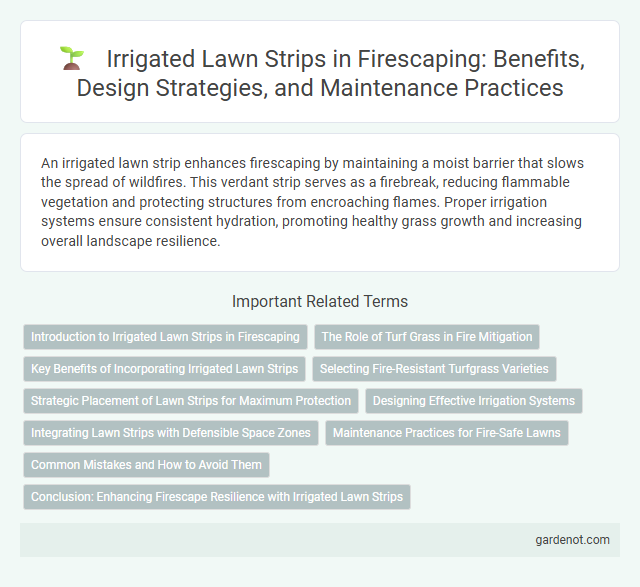An irrigated lawn strip enhances firescaping by maintaining a moist barrier that slows the spread of wildfires. This verdant strip serves as a firebreak, reducing flammable vegetation and protecting structures from encroaching flames. Proper irrigation systems ensure consistent hydration, promoting healthy grass growth and increasing overall landscape resilience.
Introduction to Irrigated Lawn Strips in Firescaping
Irrigated lawn strips serve as strategic firebreaks by maintaining lower vegetation dryness and reducing fuel loads near structures. These green buffer zones consist of regularly watered grasses that impede wildfire spread while enhancing property aesthetics. Incorporating irrigated lawn strips in firescaping effectively balances fire safety with landscape beauty and environmental health.
The Role of Turf Grass in Fire Mitigation
Irrigated lawn strips composed of fire-resistant turf grass serve as crucial barriers that slow down the spread of wildfires by maintaining higher moisture levels. Species such as Kentucky bluegrass and tall fescue retain water effectively, reducing fuel availability and heat intensity near structures. Properly maintained turf grass not only minimizes ember ignition but also enhances property protection within a defensible space framework.
Key Benefits of Incorporating Irrigated Lawn Strips
Irrigated lawn strips enhance fire safety by creating moist, green barriers that reduce the spread of wildfires near structures. These strips improve soil stability and prevent erosion, maintaining the integrity of slopes and reducing fire-prone dry debris. Integrating irrigated lawns optimizes landscape aesthetics while serving as a strategic, defensible space in fire-prone environments.
Selecting Fire-Resistant Turfgrass Varieties
Choosing fire-resistant turfgrass varieties such as Buffalo grass, Bermudagrass, and Zoysiagrass enhances the effectiveness of an irrigated lawn strip in fire-prone landscapes. These drought-tolerant species maintain higher moisture content, reducing flammability and acting as a natural firebreak around structures. Regular irrigation combined with fire-resistant turf selection minimizes ignition risks and supports landscape resilience against wildfire threats.
Strategic Placement of Lawn Strips for Maximum Protection
Strategic placement of irrigated lawn strips serves as a vital fire-resistant barrier by reducing fuel load and slowing the spread of flames near structures. Positioning these green, well-watered strips adjacent to homes and along property borders enhances defensible space by creating clear zones that firefighters can utilize during wildfire events. Optimal width and consistent irrigation ensure the lawn remains lush, significantly lowering the risk of ignition and protecting critical assets from wildland fire damage.
Designing Effective Irrigation Systems
Designing effective irrigation systems for irrigated lawn strips involves selecting water-efficient technologies such as drip irrigation or smart sprinklers to minimize water waste and maintain optimal soil moisture. Proper layout ensures even water distribution while preventing overspray onto combustible areas, reducing fire risk. Integrating sensors and timers helps automate watering schedules based on weather and soil conditions, improving landscape resilience and sustainability.
Integrating Lawn Strips with Defensible Space Zones
Irrigated lawn strips serve as effective fuel breaks when strategically integrated within defensible space zones, helping to slow wildfire spread by maintaining low flammability vegetation. Positioning these strips adjacent to home perimeters and driveways enhances firefighter access and safety by creating clear, moist barriers. Selecting drought-resistant turf varieties further optimizes water usage while ensuring continuous green zones that reduce ignition potential near structures.
Maintenance Practices for Fire-Safe Lawns
Irrigated lawn strips require consistent watering schedules to maintain healthy, green turf that resists fire spread by keeping vegetation moist and less flammable. Regular mowing to a recommended height of 3 inches helps reduce excess dry grasses and debris that can fuel fires. Periodic fertilization and aeration support root strength and lawn density, enhancing the lawn's overall fire-resistant properties.
Common Mistakes and How to Avoid Them
Overwatering irrigated lawn strips often leads to fungal growth and weak root systems, compromising fire resistance. Using non-fire-resistant grass species in these strips increases vulnerability to ignition during wildfires. To avoid common mistakes, select low-flammability grasses and implement efficient irrigation schedules that maintain moisture without promoting excess growth or disease.
Conclusion: Enhancing Firescape Resilience with Irrigated Lawn Strips
Irrigated lawn strips create effective defensible spaces by maintaining higher moisture levels that slow wildfire spread. These green buffers reduce the intensity and heat of approaching flames, protecting structures and landscapes. Integrating irrigated lawn strips into firescaping plans significantly enhances overall fire resilience in vulnerable areas.
Irrigated lawn strip Infographic

 gardenot.com
gardenot.com